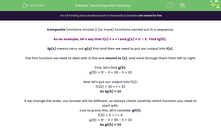Composite functions involve 2 (or more) functions carried out in a sequence.
As an example, let's say that f(x) = x + 1 and g(x) = x² - 3. Find fg(5).
fg(x) means carry out g(x) first and then we need to put our output into f(x).
The first function we need to deal with is the one closest to (x), and work through them from left to right.
First, let's find g(5):
g(5) = 5² - 3 = 25 - 3 = 22
Now let's put our output into f(x):
f(22) = 22 + 1 = 23
So fg(5) = 23
If we change the order, our answer will be different, so always check carefully which function you need to start with.
Just to prove this, let's consider gf(5).
f(5) = 5 + 1 = 6
g(6) = 6² - 3 = 36 - 3 = 33
So gf(5) = 33
In this activity, we will find outputs from composite functions involving up to three separate functions carried out in a sequence, correctly prioritising their order based on their proximity to (x).







